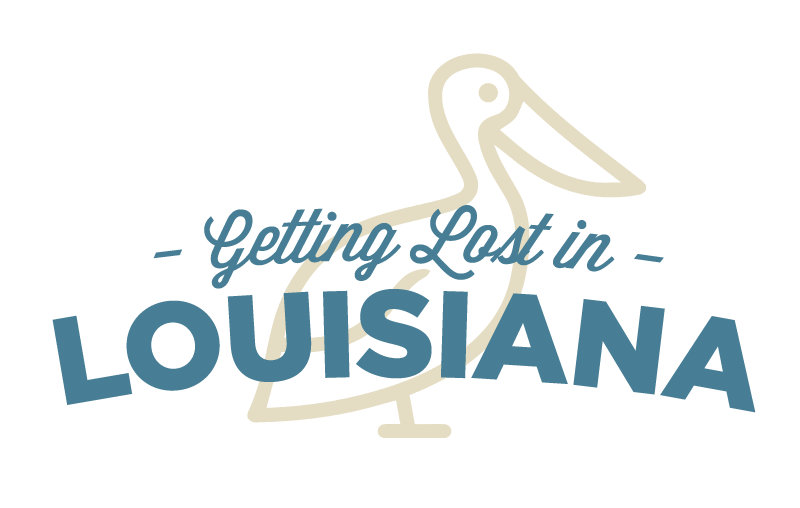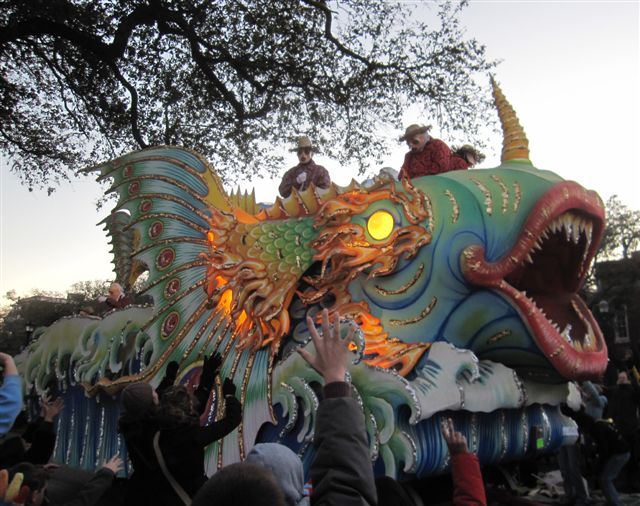
by admin | Mar 8, 2011 | Greater New Orleans
There are some things in life that children have to learn at an early age. Take football, for example. I’m determined to have my toddler, Charles, recite the LSU Fight Song before he can fully sing the alphabet. Likewise, you are never too young to learn to appreciate Mardi Gras. There is one more day left in this year’s Mardi Gras season, and August has already been to 14 parades. That’s pretty hard core for a 7-month-old.
Now there are always days, like Saturday, when you wonder if it’s worth it. We were watching Iris on Napoleon when the first drops of rain warned us it was time to leave. With no umbrella and having walked more than a mile to the parade, we didn’t have time to make it back to the house. So we holed up in a nearby coffee shop, where we sat for nearly two hours while watching a river flow down what used to be Dryades Street. Mind you, this was two hours trapped in one small room with two small children and a stroller overflowing with beads, toys and stuffed animals. All I can say is we all went to bed early that night, some of us by choice and others by force. But then the next morning, you wake up refreshed and set off again to enjoy the last few days before Lent.
 |
| Charles with his “trombone.” |
I’ve learned that age plays a large part in enjoyment level. The super krewes of Bacchus, Endymion and Orpheus, with their celebrity riders and elaborate floats, draw the huge crowds. At one time, my husband and I were annual regulars at these three parades. Then, enter two small children. Priorities change and so do our parade plans.
Take Charles, for starters. Three weeks shy of turning three, his latest obsession (along with Batman and Spiderman) is trombones. Sure, the throws are nice, and a nervous breakdown is almost always in the forecast when he doesn’t catch a football, but mostly he’s there to get up close and personal with the bands. He wants to be on the front row and have plenty of room to dance and march at his leisure, which equals no love affair with large crowds.
 |
| August enjoying a parade. |
Now, August, on the other hand, wants nothing to do with loud noises. You can imagine our dilemma with that one. After the first parade, though, I discovered that all he really wants is to be held close — cocoon-like — so he can drift off to sleep. With this revelation, I packed him tightly into his Moby Wrap, and for the next 13 parades, he had the best sleep in ages.
Armed with our new knowledge and lots of trials and errors, we finally developed some pretty sound advice for other families venturing out into carnival: 1) Start at the beginning of the route. If a parade begins on Magazine and Jefferson at 5 p.m., don’t try and catch it on Napoleon or St. Charles — and certainly not on Canal. Go to Magazine. On any given day, the crowds range from light to manageable, and you rarely have to fight a ladder for a good viewing spot. 2) Bring lots of snacks and drinks. You might think you’ll only be there an hour, but the reality is going to be much longer. 3) If you can, walk from your house. In the long run, it’ll be quicker and easier. If you must drive, go late and check out the close spots first before parking a mile away. We’ve been lucky on several occasions, garnering a choice spot just a block from the route minutes before the parade started. 4) Be mentally prepared to leave when necessary. While Mardi Gras is all about having fun, it often also means no naps, long hours of over-stimulation, countless sugar highs from all that king cake and daily meltdowns over a lost blinking dragon or broken sword. 5) And, lastly, bring an umbrella. You never know when you’re going to need it.
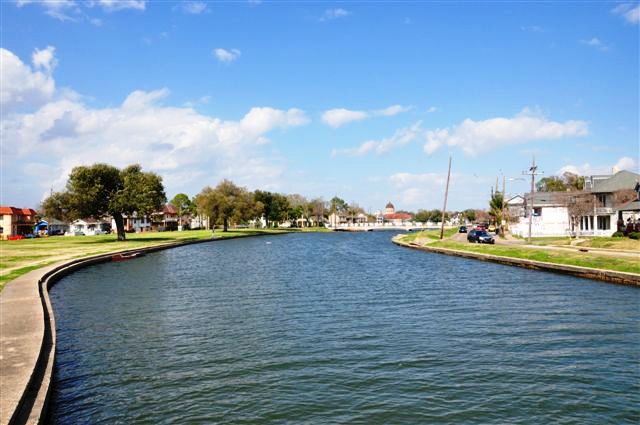
by admin | Feb 22, 2011 | Greater New Orleans
Some days you know from the minute you wake up that today is not a day to go traveling. The piles of laundry are glaring at you, the empty fridge is pleading to be filled and the impending start of the workweek is gnawing at your conscience. But, then again, the weather was gorgeous – a perfect 73 degrees in mid-February – and we just couldn’t bear to stay inside. So we compromised and decided to venture out to some of our favorite places in the city before rushing home to do the chores
New Orleans is a city filled with hidden gems waiting to be discovered. Unlike the French Quarter or the Audubon Zoo, these are the places not labeled on the map, the places no one draws attention to, yet they are often some of the most interesting. Bayou St. John is one such area. A natural bayou starting at Lake Pontchartrain, the waterway was once used by Native Americans, trappers and early explorers as an early transportation route. Today, lavish homes grace its edges, and canoes are often seen skimming its surface.
We started the morning out near the bayou’s mouth at the lake, where the remnants of Fort St. Jean are slowly vanishing into nature. Hitched on my hip, Baby August was, as usual, content with being along for ride. Charles, on the other hand, marched out of the car as if he owned the place. Climbing on the crumbling brick walls, scaling the nearby levee and chasing lizards, he was merely warming up his endless reserves of energy.
 |
| Tree swing in City Park’s Couturie Forest |
Next stop was the Couturie Forest in City Park. Heavily damaged by Hurricane Katrina, the trail no longer immerses you deep in the woods. But, it’s still secluded and quiet, meandering along one of the park’s many bayous. We hiked along the wood-chipped path, commenting on the growth of the more than 2,000 trees planted last year. Soon, it would be a thriving forest again.
The first half of the walk was fairly uneventful. August had long since dozed off, lulled to sleep by the warm breeze pushing us along. Charles was racing ahead, searching out the tree swing he knew was around the corner. As my husband pushed him high in the air, I watched a group of turtles sunbathing on a log. A duck gliding to a stop in the water drew my gaze up, and I gasped as I noticed a 5-foot alligator staring back at me from a nearby island. Aside from the child-sized tee-pee next to the swing, the alligator was certainly the highlight of Charles’ trip. We had to bribe him with the promise of shrimp for lunch to tear him away and head back to the car.
 |
| Parkway Bakery and Tavern |
Starving after the morning’s exertion, we stopped off at Parkway Bakery and Tavern for some poboys and sweet potato fries. The place was packed, but service was quick, and we soon sunk our teeth into the shrimp and catfish overflowing the soft French bread. Parkway sits at the far end of Bayou St. John and is an ideal place to leave your car and take a walk along one of the most scenic spots in the city.
With just an hour left until Charles’ dreaded afternoon nap, we decided to treat him to a hot chocolate and some last-minute playtime at “the little park by the coffee shop.” On a small side street branching off of Esplanade Avenue stands an eclectic grouping of shops and restaurants, including Fair Grinds coffeehouse. Considering the place his second home, my toddler walked up to the counter and ordered his drink before we made it through the door. After slurping it down, he ran outside to find the coveted tricycle the shop keeps on hand for pint-sized visitors. We patiently followed behind, sipping our coffees as he made his slow circuit around the block.
 |
| Quality time spent in Fortier Park. |
After the tricycle was once again stowed away under the outside stairs, we crossed the street to Fortier Park, a tiny gem lovingly landscaped and decorated by the park’s neighbors. We hit all the high points, from rearranging the horses on the chess boards to reading the laminated children’s poetry books tied to the benches. An elaborately carved birdhouse–complete with kitchen table, chair and bed–provides an ideal home for the plastic lizard who’s joined us on today’s trip. Downing the final drops of my coffee, I check my watch and break the news that it’s time to head home where nap time and chores await us.

by admin | Jan 30, 2011 | Greater New Orleans
Stifled from days of cold weather (40 degrees is frigid for New Orleans!), we took advantage of a warm spell and ventured out of the city to Jean Lafitte National Park.
The park proved to be an ideal location to take two small children. We started off in the visitor’s center, where my nearly three-year-old was fascinated by the life-like, stuffed animals–especially the owl peering down at him from the tree and the armadillo trying to hide out of view.
Outside on the trails, he ran freely down long lengths of boardwalks, prodded along by the hope of seeing an alligator or snake. Even though the alligators were hibernating, there were still signs of life throughout the area, including a baby raccoon foraging in the underbrush. Meanwhile, our baby had the best sleep in days, wrapped up snugly in his Moby Wrap, enjoying the swaying motion of my walk.
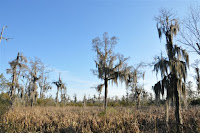 |
| Cypress trees covered in moss. |
While my husband snapped away with the camera, I found that the stress of the work week slid away with each step we took farther into the swamp. Winter is my favorite time to visit Jean Lafitte. The relatively small crowds give you complete ownership of the area, and the crisp air frightens away the multitudes of bugs that try to carry you off in the summer. The cypress trees, laden with moss, are particularly haunting against the blue sky, while the waist-high palmettos entrance you with their gentle swaying in the breeze.
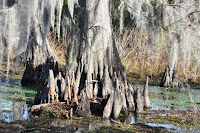 |
| Cypress knees |
There are several trails at the National Park, some on land through swampland and forest and others on water, beckoning exploration with a canoe. One of my favorites is the Bayou Coquille trail, which begins in a hardwood forest and descends through palmettos and bald cypress trees to a freshwater marsh. Here, you can continue on to the Marsh Overlook trail, which offers some of the best views of wildlife in warmer weather and gives a glimpse into the logging taking place here in the 1800s.
Because Jean Lafitte is so easily accessible from New Orleans, I never feel the need to explore every inch of the park in one visit. If I miss something today, I can always find it next time. Thus, after a nice hike along the Palmetto Trail, we climbed back in the car and headed a short distance to where Lafitte Parkway dead ends in the town of Jean Lafitte.
 |
| Shrimp boats in Jean Lafitte |
A fishing village outside of the protective levee system, Jean Lafitte always surprises me with its beautiful homes high up on piers. Not your typical fishing camps, this town hosts year-round residents who make their livings off of the Gulf waters that crisscross the land through their backyards.
The town’s namesake, the notorious pirate Jean Lafitte, ran a smuggling outfit based in Barataria Bay to the south. A privateer in the early 19th century, Lafitte gained fame–and a pardon–after his efforts to help General Andrew Jackson win the Battle of New Orleans during the War of 1812.
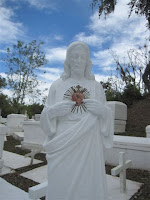 |
| Cemetery in Jean Lafitte |
|
|
Jean Lafitte (the town) hides many secrets just steps away from the main road, like the whitewashed cemetery overlooking serene Bayou Barataria. Today we discovered another quiet walk at the end of City Park Drive behind the newly built Multi-Purpose Center. The exercise helped us feel better about the gumbo and fried fish we had just eaten at Boutte’s restaurant, where an empty upstairs dining room sheltered the other patrons from our lively children. We were the only ones out there on the trail that day, a fact I was thankful for when my potty-training toddler discovered the wonderment of peeing on a tree.
As we drove away that afternoon, a brown pelican unfurled its massive wings and took flight, skimming the bayou’s waters underneath. It was an image we all carried with us as we drove up the ramp to the Westbank Expressway and saw the city’s skyline on the other side of the Mississippi River.



